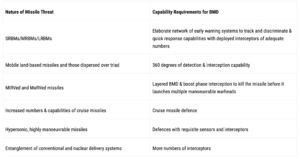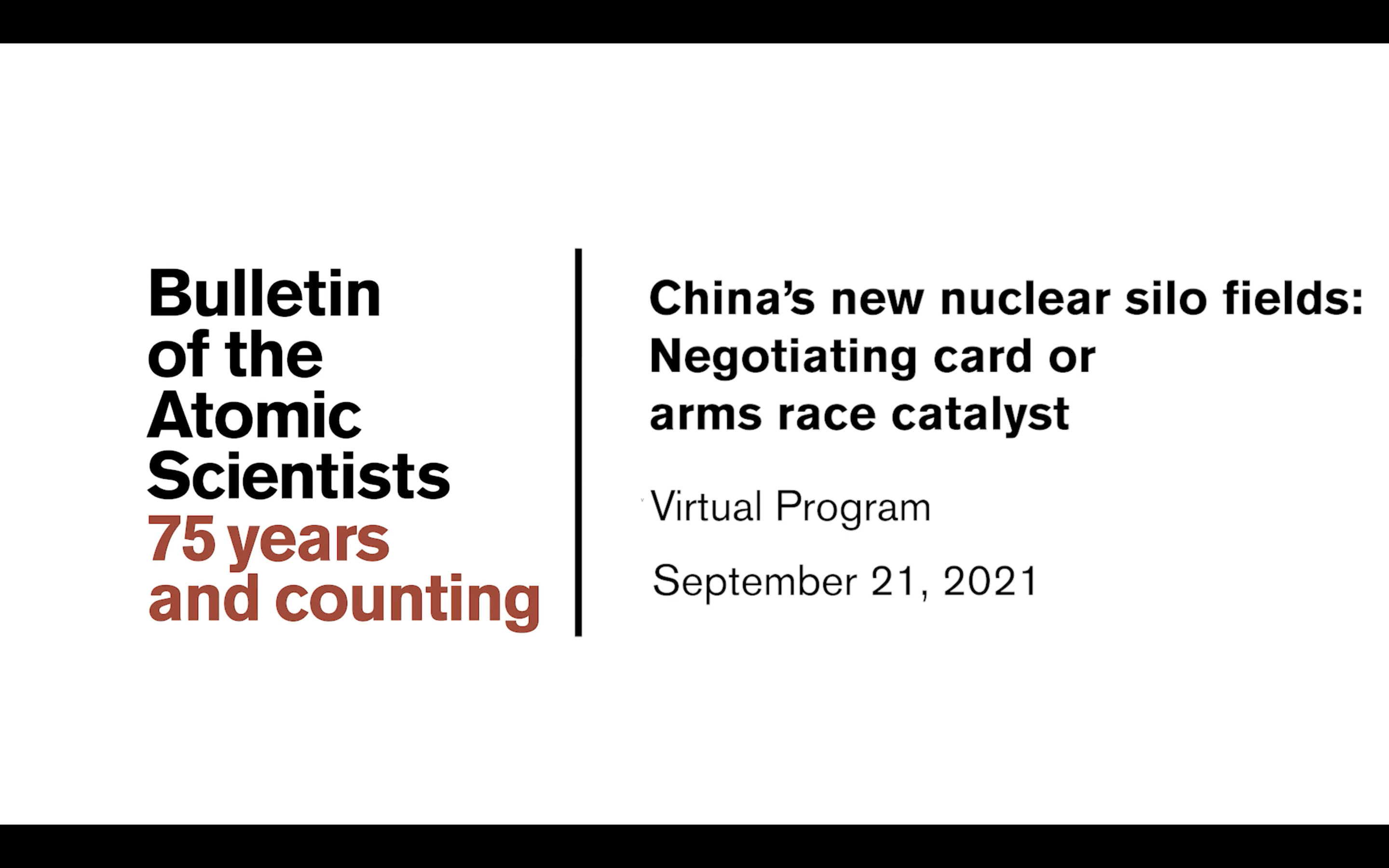Ballistic Missile Defence in Nuclear Strategy
CENTER FOR AIR POWER STUDIES
APLN Senior Research Adviser Manpreet Sethi analyses the role ballistic missile defense (BMD) should play in supporting India’s nuclear strategy and how it can be deployed to provide domestic assurance without pushing adversaries towards actions that create security dilemmas. To read the full report, please download the file on the left. The original post can be found here.
Oppenheimer, the movie, has drawn widespread public attention to nuclear issues. This is a timely release since the memory of the death and destruction that rained down on Hiroshima and Nagasaki with just one atomic bomb each has been fading. The movie tells the story of the American physicist J. Robert Oppenheimer, who led the team that built the first atomic bomb. It has triggered conversations about the effects of these weapons. It would, hopefully, rein in the causal references to nuclear weapons and encourage measures to prevent deterrence breakdown.
Once earlier, a movie had prompted a leader to relook at his country’s nuclear strategy. In October 1983, after watching The Day After, an American television film, the then US President Ronald Reagan noted that it was “very effective and left me greatly depressed.” Determined to protect his country against such fate, Reagan doubled down on his idea of building an elaborate missile defence that he had proposed earlier the same year as a “means of rendering these nuclear weapons impotent and obsolete.”[1] The movie strengthened his faith in ballistic missile defence (BMD).
This was to mark the start of the end of the anti-ballistic missile (ABM) treaty, a bilateral agreement that the USA and USSR had concluded in 1972. This instrument had emerged from the offence–defence spiral that raged between the two superpowers during the 1950s-60s. With the maturing of technology for multiple independently retargetable vehicles (MIRV), where one missile could carry several warheads, the balance skewed in favour of offence, making defences difficult and expensive. Consequently, both sides saw prudence in accepting nuclear deterrence based on mutual vulnerability rather than building defences whose efficacy, even in theory, seemed doubtful.[2]
Thus, the ABM treaty was born. It limited the deployment of BMD to only one site each in the USA and USSR, leaving the rest of the country vulnerable to each other’s nuclear attacks. The treaty underscored that nuclear deterrence best functions on the ability to cause unacceptable damage, which in the case of the superpowers meant mutual assured destruction. It was agreed that defences destabilise deterrence by causing insecurities, forcing the adversary towards increasing offensive systems to saturate defence, countermeasures to defeat defence, and provoking counter-countermeasures to enhance defence.
While limiting BMD deployments, the ABM treaty, however, did not prohibit research and development (R&D) on missile defence technologies. With the end of the Cold War, as US threat perceptions changed to the need to defend against limited ballistic missile attacks from states with small missile inventories, advances in BMD technologies offered a viable solution. This encouraged the Clinton administration to legislate the National Missile Defense Act in 1999, which committed the US to “deploy as soon as is technologically possible an effective NMD system capable of defending the territory of the US against limited ballistic missile attack (whether accidental, unauthorized or deliberate)”.[3]
Moving ahead, President George W Bush Jr., in a speech at the National Defense University (NDU) on May 1, 2001, announced that “deterrence can no longer be based solely on the threat of nuclear retaliation”[4] because the world had become “a less certain, a less predictable one”. So, missile defence was included as a major plank of the US national security strategy. On December 13, 2001, Washington gave Moscow formal notice of its withdrawal from the ABM treaty, and six months later, in mid-June 2002, the US abandoned the treaty. Thereafter, the USA has been actively engaged in developing and deploying theatre missile defences for the protection of allies and a limited ground-based missile defence capability for the protection of the mainland. It has often been repeated that US’ BMD is meant to defend against the small arsenals of ‘rogue’ states and not to disrupt Russian or Chinese nuclear deterrence.
American statements notwithstanding, its BMD efforts have, not unexpectedly, evoked concerns in Russia and China about the erosion of the credibility of their nuclear deterrence, especially as technology advances. They fear that the confidence provided by a missile defence, coupled with the availability of highly accurate counterforce missiles, could embolden the USA to undertake a first strike. To avert such a possibility, both have engaged in building countermeasures, as well as their own missile defences. The deployment of MIRVed and manoeuvrable re-entry vehicle (MaRVed) missiles, hypersonic delivery systems, cruise missiles, and autonomous systems are all responses to BMD. More recently, Russia’s Poseidon underwater autonomous nuclear delivery system is an example of President Putin’s attempt to build an “invincible arsenal”.[5] China’s fractional orbital bombardment system (FOBS), tested for the first time in 2021, falls into the same category.[6]
Meanwhile, even after spending hundreds of billions of dollars on its BMD capabilities, Washington cannot claim absolute confidence in its missile defence, especially as countermeasures have improved. The BMD has created security dilemmas by pushing adversaries towards capabilities that could saturate or defeat the BMD. Is BMD then a useful capability? Should India be moving in this direction?
BMD Efforts in India
India’s BMD effort came into public view when the Defence Research and Development Organisation (DRDO) conducted an exo-atmospheric test 50 km above the earth on November 27, 2006. This involved the interception of a Prithvi ballistic missile by another modified Prithvi interceptor missile. On December 6, 2007, India fired a hypersonic interceptor missile that destroyed an incoming missile in a direct hit over the Bay of Bengal. This endo-atmospheric interception took place at an altitude of 15 km and reportedly used the Green Pine radar purchased from Israel for tracking and cueing. In March 2009, a third interception was carried out of a Dhanush missile (naval version of Prithvi) fired from a ship and intercepted by Prithvi Air Defence (PAD) at a height of 70-80 km. Then, in July 2010, yet another modified Prithvi simulated the enemy missile and was shot down by a supersonic interceptor missile from Advanced Air Defence (AAD) at an altitude of 15 km. Thereafter, in 2012, the first phase of a two-tier BMD, capable of intercepting missiles up to a range of 2000 km in the exo- and endo-atmospheres was announced as ready for deployment to protect “vital” Indian assets. DRDO also claimed that this system was better than the American Patriot system in “interception, range and altitude”.[7]
The second phase of the programme has been undergoing testing since 2017 to build the capability to engage missiles of a range up to 5000 km. On November 2, 2022, India announced the successful flight test of this phase using the AD-1, an interceptor missile designed for low exo-atmospheric and endo-atmospheric interception of long-range ballistic missiles as well as aircraft.
India’s advances in BMD are no mean feat, given that it has built indigenous capability in the face of technology denial. There have also been spin-off benefits for space capabilities, such as anti-satellite testing. But can a BMD be effective against the kinds of missiles, in quantity and quality, that India’s adversaries possess? What kind of BMD would India need? How should the capability be deployed? How should this be communicated to the adversaries to avoid creating security dilemmas? The following sections examine the nature of India’s missile threat environment and the likely best use of the BMD to mitigate these threats effectively.
Nature of India’s Missile Threat
For the USA, the BMD offered a solution to the threat from a handful of missiles from states of proliferation concern whose missile arsenals were expected to be in low, two-digit numbers and of modest capability without any sophisticated countermeasures.
The profile of India’s missile threat, in comparison, is far more complex. Both China and Pakistan have robust missile arsenals of substantive quality and quantity. In fact, both countries have spent the last decade enhancing their missile capabilities in terms of numbers, range, accuracy, reliability, and penetrability. The focus in both has been to move from liquid to solid propulsion technologies to enhance missile mobility. China has also worked on equipping them with countermeasures and making them MIRVed as well as MaRVed in view of its threat perception from the US BMD. Pakistan, too, has tested the MIRVed capability on the Ababeel missile and has indicated an intention to MarRV. China has, in the past, had no compunctions about transferring its nuclear weaponry, designs, and missile technology[8] to Pakistan for strategic gains, and the same applies to the transfer of BMD countermeasures, too, as was evident in China supplying Pakistan with the multiple object tracking radar to assist its MIRVed capability.[9] Both countries have also deployed a growing number of dual-use cruise missiles. Also evident in both nations is a focus on training with mobile missile units, many of which are claimed to possess both conventional and nuclear-capable missiles. China has also progressed on its own BMD.[10]
In view of such a challenging missile threat environment, an Indian BMD will have to be of high sophistication to offer even a modicum of effectiveness. This would warrant liberal spending on the development of a widespread network of early warning systems, the deployment of requisite numbers of interceptors, dedicated cruise missile defences, as well as dogged R&D to move towards boost phase interception given the need to intercept as far away from its own territory as possible. The table below provides a snapshot of some of the capability requirements of an Indian BMD in keeping with the missile threat environment.
Missile Capability Assessment and Implications for BMD.

So, how best can India use a BMD?
It is clear from the above that the technical capabilities of a BMD that can sufficiently defend India are going to be of a high order. Higher, in fact, than what the US had envisaged with its own threat perception. The costs of the system, accordingly, will be significant too.
Therefore, it is critical to have absolute clarity on the role that BMD should play in supporting India’s nuclear strategy. What should it aim to achieve – national missile defence; theatre defence? or point/area defence? Where should BMD be deployed? What kinds of national assets should it defend? What should be the declaratory position on this? These are important issues not just for the assurance of the public in a democracy but also for signalling the nature of the build-up to the adversary so as to shape his responses.
The guide for India’s BMD development and deployment should be its No First Use strategy. Given that India deters by suggesting assured retaliation to cause unacceptable damage, the BMD can best be used to protect retaliatory capabilities to ensure the imposition of such damage. Common sense suggests that BMD should protect the Nuclear Command Authority, the national capital, and the nuclear storage sites, delivery vectors, and communication nodes. Since no amount of BMD can guarantee a hundred per cent success in the interception of every incoming missile into every city, and since India cannot afford astrodome protection of its entire landmass, the effort should be restricted to the protection of assets most needed for credible deterrence. Such a BMD could be for limited, area-specific deployment to provide insurance against pre-meditated, mistaken, or unauthorised launches. It would complement other efforts towards arsenal survivability, such as dispersion, deception, hardening, etc.
India should be clear-eyed about the pros and cons of BMD. Technological advances invoke euphoria. But the right kind of technology build-up based on a considered assessment of threats and requirements is imperative. So is prudent political signalling that explains the limit of the enterprise so as not to get an alarmed adversary to create future security dilemmas. In fact, it might be worthwhile to examine the possibilities of ABM agreements.
Tempering the Lure of the BMD
Undoubtedly, the political and technological lure of the BMD is high. After all, which political leader would not want to assure his populace that he is taking steps to ensure their protection? It sounds politically incorrect and illogical to suggest otherwise. Also, scientists and technologists relish complex challenges. But there are political and financial implications of this exercise. And realistically speaking, there are no guarantees of its robustness!
Given the above, would it not be meaningful to explore a multilateral ABM treaty among all nuclear-armed states? Today’s vexed political relations between major nuclear powers and the conundrum of the extant strategic chains do not support the possibility of bilateral ABM agreements. But BMD could prove to be an issue to bring together the five NWS, alongside India and Pakistan. In fact, an ABM agreement that ropes in all the seven countries can not only be a useful confidence-building measure but also an example of modern arms control in the contemporary multipolar nuclear reality.
Such an ABM treaty could allow all nations to deploy BMD systems on one or two sites of their choice with a fixed number of interceptors. This would help them retain confidence in the survival of their retaliatory assets to cause unacceptable damage to an otherwise vulnerable adversary. Such reassurance could enhance deterrence and reduce the momentum of an offence-defence spiral. Most importantly, it would provide an opportunity for the nuclear-armed states to come together to discuss a win-win solution since BMDs are not fool-proof umbrellas, especially with the newer kinds of missiles on the anvil.
A change in political relations with the building of confidence over a limited, transparent, and, if possible, verifiable BMD would be a better guarantee of defence than a BMD that promises to put locks on the front door of the house but leaves windows open. The idea of a multilateral ABM treaty or agreement could certainly use more exploration.
*********
Notes
[1] “President Reagan’s Ambitious Star Wars Defence Plan”, Groovy History, https://groovyhistory.com/president-reagans-ambitious-star-wars-defense-plan/2. Accessed on 19 Jul 2023.
[2] Keith B Payne, “The Case for National Missile Defense.” Orbis, Vol 44, no. 2, March 2000, pp. 187–96. https://doi.org/10.1016/s0030-4387(00)00020-x.
[3] ”Missile Defence and the ABM Treaty: A Status Report”, SIPRI Fact Sheet, June 2001. https://sipri.org/sites/default/files/files/FS/SIPRIFS0106.pdf. Accessed on Jul 23, 2023
[4] “Remarks by the President at National Defense University”, The White House, May 1, 2001, https://georgewbush-whitehouse.archives.gov/news/releases/2001/05/20010501-10.html. Accessed on
[5] HI Sutton, “Russia’s New ‘Poseidon’ Super-Weapon: What you Need to Know”, Naval News, March 3, 2022, https://www.navalnews.com/naval-news/2022/03/russias-new-poseidon-super-weapon-what-you-need-to-know/. Accessed on Jul 12, 2023.
[6] Demetri Sevastopulo & Kathrin Hille, “China Tests New Space Capability with Hypersonic Missile”, Financial Times, October 17, 2021.
[7] G Bharath and Harsh V Pant, “A Step Closer to Missile Defence”, Tribune, December 23, 2007.
[8] WikiLeaks cables amply document this by showing the several occasions on which the US raised the matter of Chinese firms providing Pakistan’s Heavy Mechanical Complex and National Development Complex, both involved in making of missiles, with ring rolling machines, flow forming machines for missile airframes as well as fibre coil winning machines and integrated optical chips.
Pranab Dhal Samanta, “Wiki: China helping Pak Upgrade its Missiles”, Indian Express, September 12, 2011.
[9] “Pakistan Gets Tracking System from China that could Speed up multi-warhead Missile Program”, The Hindustan Times, March 20, 2018.
[10] Manoj Joshi, “Decoding China’s BMD and ASAT Systems Efforts”, ORF Expert Speak, April 6, 2019, https://www.orfonline.org/expert-speak/chinas-bmd-asat-progress-49578/. Accessed on Jul 24, 2023.
Recommended Readings
- Ernest J Yanarella, The Missile Defence Controversy: Technology in Search of a Mission (New Delhi: Knowledge World, 2011)
- Happymon Jacob, “Consider a Trilateral Asian ABM Treaty”, in Michael Krepon et al eds., Off Ramps from Confrontation in Southern Asia (Washington DC: Stimson Centre, 2019)
- Jerome Grossman, “The Politics of Star Wars: The Reagan Legacy and the Strategic Defence Initiative” The Notre Dame School Journal of Legislation, Available at: https://scholarship.law.nd.edu/jleg/vol15/iss2/4
- National Research Council of the National Academies, Making Sense of Ballistic Missile Defence, Consensus Study Report, 2012
- Manpreet Sethi, “Nuclear Strategies in the Age of Missile Defences”, Air Power Journal, vol.2, no.3, Jul-Sep 2005, pp. 159-184.




